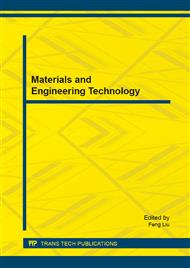[1]
S. Choi V.G. Agelidis,J. Yang,D. Coutellier and P. Marabeas,Analysis,design and experimental results of a floating-output interleaved-input boost-derived DC-DC high-gain transformer-less converter, ,IET Power Electron,2011,vol. 4,iss. 1,pp.168-180.
DOI: 10.1049/iet-pel.2009.0339
Google Scholar
[2]
L. Huber and M. M. Jovanovic, A design approach for server power supplies for networking, in Conf. Rec. IEEE Appl. Power Electron. Conf, 2000, p.1163–1169.
Google Scholar
[3]
H. Matsuo and K. Harada, The cascade connection of switching reg-ulators, IEEE Trans. Ind. Appl., vol. IA-12, no. 2, p.192–198, Mar. /Apr. l976.
DOI: 10.1109/tia.1976.349401
Google Scholar
[4]
Shih-Ming Chen,Tsorng-Juu Liang,A Quadratic High Step-Up DC-DC Converter with Voltage Multiplier, ,2011 IEEE International Electric Machines & Drives conference, pp.1025-1029.
DOI: 10.1109/iemdc.2011.5994741
Google Scholar
[5]
Shih-Ming Chen,Tsorng-Juu Liang,Lung-Sheng Yang,Jiann-Fuh Chen,A Cascaded High Step-Up DC–DC Converter With Single Switch for Microsource Applications, ,IEEE Trans. Power Electron,vol. 26,no. 4,April 2011,pp.1146-1153.
DOI: 10.1109/ecce.2009.5316477
Google Scholar
[6]
Lung-Sheng Yang, Tsorng-Juu Liang, Hau-Cheng Lee, and Jiann-Fuh Chen, Novel High Step-Up DC–DC Converter With Coupled-Inductor and Voltage-Doubler Circuits, , IEEE Transactions on Industry Electronics, vol. 58, no. 9, September 2011,pp.4196-4206.
DOI: 10.1109/tie.2010.2098360
Google Scholar
[7]
M. ZhuF.L. Luo,Voltage-lift-type Cuk converters:topology and analysis,, IET Power Electron, 2009,vol. 2,iss. 2,pp.178-191.
Google Scholar
[8]
M. ZhuF.L. Luo,Series SEPIC implementing voltage-lift technique for DC-DC power conversion, , IET Power Electr on,2008,Vol. 1,No. 1,pp.109-121.
DOI: 10.1049/iet-pel:20060494
Google Scholar
[9]
Miao Zhu and Fang Lin Luo,Enhanced Self-Lift Cuk Converter for Negative-to-Positive, ,IEEE Transactions on Power Electronics,Vol. 25,No. 9,September,2010,pp.2227-2233.
DOI: 10.1109/tpel.2010.2047269
Google Scholar
[10]
K.I. Hwu, Chun-Chen Lin, and Jenn-Jong Shieh, A Simple Step-Up Converter, IEEE PEDS 2011, Singapore, December (2011).
DOI: 10.1109/peds.2011.6147295
Google Scholar
[11]
K. I. HwuandY.T. Yau, High Step-Up Converter Based on Charge Pump and Boost Converter, IEEE Transactions on Power Electronics, Vol. 27, No. 5, May (2012).
DOI: 10.1109/tpel.2011.2175010
Google Scholar
[12]
F.L. Luo and H. Ye,Positive-output cascading boost converters, ,Proc. -Elect. Power Appl,vol. 151,no. 5,2004,p.590–606.
Google Scholar
[13]
Ma. Guadalupe Ortiz-Lopez,J. Leyva-Ramos L. H,Multiloop Controller for N-Stage Cascading Boost Converter, ,16th IEEE International Conference on Control Applications,2007,pp.587-592.
DOI: 10.1109/cca.2007.4389295
Google Scholar


